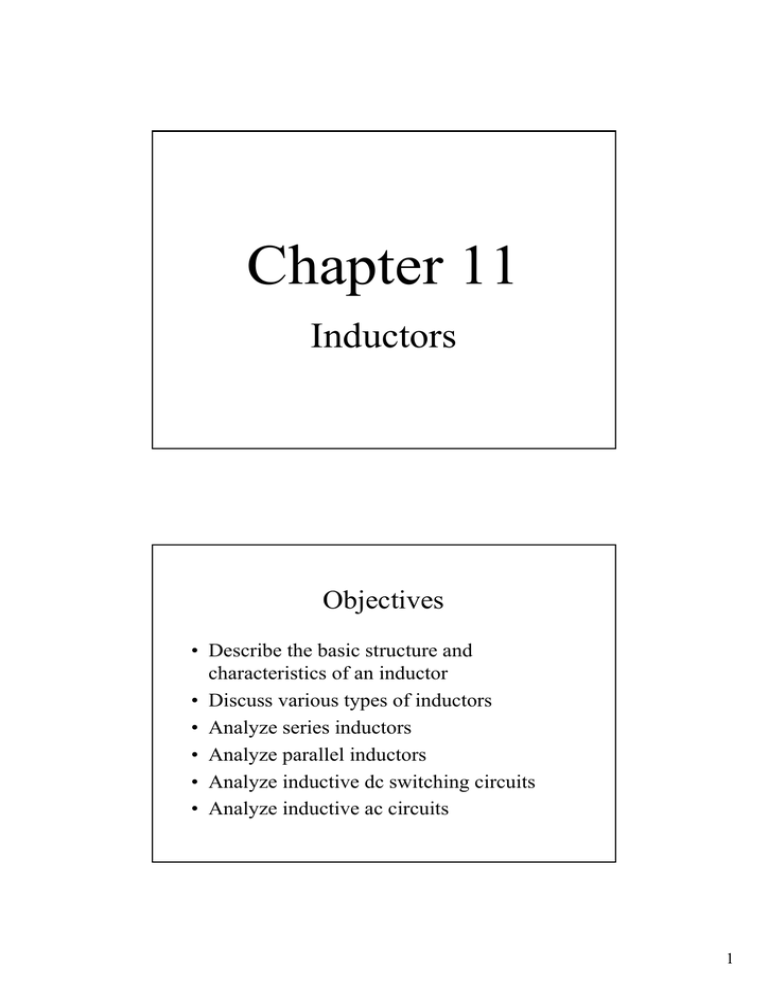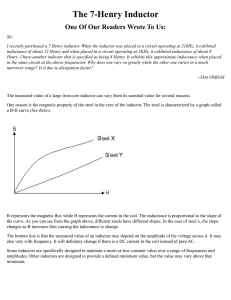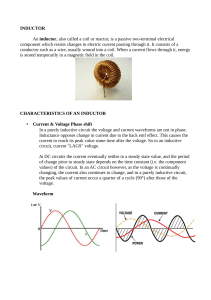Chapter 11
advertisement

Chapter 11 Inductors Objectives • Describe the basic structure and characteristics of an inductor • Discuss various types of inductors • Analyze series inductors • Analyze parallel inductors • Analyze inductive dc switching circuits • Analyze inductive ac circuits 1 The Basic Inductor • When a length of wire is formed onto a coil, it becomes a basic inductor • Magnetic lines of force around each loop in the winding of the coil effectively add to the lines of force around the adjoining loops, forming a strong electromagnetic field within and around the coil • The unit of inductance is the henry (H), defined as the inductance when one ampere per second through the coil, induces one volt across the coil Self-Inductance • Inductance is a measure of a coil’s ability to establish an induced voltage as a result of a change in its current, and that induced voltage is in a direction to oppose that change in current • An inductor stores energy in the magnetic field created by the current: W = 1/2 LI2 2 Physical Characteristics • Inductance is directly proportional to the permeability of the core material • Inductance is directly proportional to the crosssectional area of the core • Inductance is directly proportional to the square of the number of turns of wire • Inductance is inversely proportional to the length of the core material L = N2µA/l Winding Resistance and Capacitance • When many turns of wire are used to construct a coil, the total resistance may be significant • The inherent resistance is called the dc resistance or the winding resistance (RW) • When two conductors are placed side-by-side, there is always some capacitance between them • When many turns of wire are placed close together in a coil, there is a winding capacitance (CW) • CW becomes significant at high frequencies 3 Faraday’s and Lenz’s Laws • Recall Faraday’s law: – The amount of voltage induced in a coil is directly proportional to the rate of change of the magnetic field with respect to the coil • Recall Lenz’s law: – When the current through a coil changes and an induced voltage is created as a result of the changing electromagnetic field, the direction of the induced voltage is such that it always opposes the change in current 4 Typical Inductors Series Inductors • When inductors are connected in series, the total inductance increases LT = L1 + L2 + L3 + … + Ln 5 Parallel Inductors • When inductors are connected in parallel, the total inductance is less than the smallest inductance 1/LT = 1/L1 + 1/L2 + 1/L3 + … + 1/Ln Inductors in DC Circuits • When there is constant current in an inductor, there is no induced voltage • There is a voltage drop in the circuit due to the winding resistance of the coil • Inductance itself appears as a short to dc 6 RL Time Constant • Because the inductor’s basic action opposes a change in its current, it follows that current cannot change instantaneously in an inductor τ = L/R where: τ is in seconds (s) L is in henries (H) R is in ohms (Ω) Energizing Current in an Inductor • In a series RL circuit, the current will increase to approximately 63% of its full value in one timeconstant (τ) interval after the switch is closed • The current reaches its final value in approximately 5τ 7 De-energizing Current in an Inductor • In a series RL circuit, the current will decrease to approximately 63% of its fully charged value one time-constant (τ) interval after the switch is closed • The current reaches 1% of its initial value in approximately 5τ; considered to be equal to 0 Induced Voltage in the Series RL Circuit • At the instant of switch closure, the inductor effectively acts as an open with all the source voltage across it • During the first 5 time constants, the current is building up exponentially, and the induced coil voltage is decreasing • The resistor voltage increases with current • After 5 time constants, all of the source voltage is dropped across the resistor and none across the coil 8 Exponential Formulas • The general formulas for RL circuits are: v =VF+ (Vi - VF)e-Rt/L i =IF+ (Ii - IF)e-Rt/L Where VF and IF are final values of voltage and current, Vi and Ii are initial values of voltage and current, v and i are instantaneous values of induced voltage or current at time t Increasing/Decreasing Current • The special formula for an RL circuit charging from zero is: i =IF (1 - e-Rt/L ) • The special formula for an RL circuit discharging to zero is: i =Iie-Rt/L 9 Current and Voltage in an Inductor • According to Faraday’s law: increase in frequency induces more voltage across the inductor in a direction to oppose the current and causes it to decrease in amplitude • Lenz’s law states that the polarity of induced voltage is such that the resulting induced current is in a direction that opposes the change in the magnetic field that produced it Inductive Reactance • Inductive reactance is the opposition to sinusoidal current, expressed in ohms • The inductor offers opposition to current, and that opposition varies directly with frequency • The formula for inductive reactance, XL, is: XL = 2πf L 10 Phase Relationship of Current and Voltage in an Inductor • The current lags inductor voltage by 90° • The curves below are for a purely inductive circuit Power in an Inductor • Instantaneous power (p) - the product of v and i gives instantaneous power • True Power (Ptrue) - ideally is zero, since all power stored by an inductor in the positive portion of the power cycle is returned to the source during the negative portion. Because of winding resistance, the true power is: Ptrue = (Irms)2RW 11 Reactive Power • The rate at which an inductor stores or returns power is called its reactive power (Pr), with units of VAR (volt-ampere reactive) • The reactive power is a nonzero quantity, because at any instant in time, the inductor is actually taking energy from the source or returning energy to it Pr = VrmsIrms or Pr = V2rms/XL or Pr = I2rmsXL Quality Factor (Q) of a Coil • The quality factor (Q) is the ratio of the reactive power in the inductor to the true power in the winding resistance of the coil or the resistance in series with the coil Q = (reactive power) / (true power) Q = XL/RW 12 Summary • Self-inductance is a measure of a coil’s ability to establish an induced voltage as a result of a change in its current • An inductor opposes a change in its own current • Faraday’s law states that relative motion between a magnetic field and a coil induces voltage across the coil Summary • The amount of induced voltage is directly proportional to the inductance and the rate of change in current • Lenz’s law states that the polarity of induced voltage is such that the resulting induced current is in a direction that opposes the change in the magnetic field that produced it • Energy is stored by an inductor in its magnetic field 13 Summary • One henry is the amount of inductance when current, changing at the rate of one ampere per second, induces one volt across the inductor • Inductance is directly proportional to the square of the number of turns, the permeability, and the cross sectional area of the core. It is inversely proportional to the length of the core Summary • The permeability of a core material is an indication of the ability of the material to establish a magnetic field • The time constant for a series RL circuit is the inductance divided by the resistance • In an RL circuit, the voltage and current in an energizing or de-energizing inductor make a 63% change during each time-constant interval 14 Summary • Energizing and de-energizing follow exponential curves • Inductors add in series • Total parallel inductance is less than that of the smallest inductor in parallel • Current lags voltage by 90° in an inductor • Inductive reactance (XL) is directly proportional to frequency and inductance Summary • The true power in an inductor is zero; that is, there is no energy loss in an ideal inductor due to heat, only in its winding resistance 15







